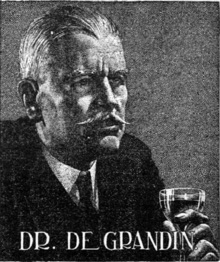…and saved weird fiction.
Really? Weird Tales and weird fiction owe their existence to one man? The Unique Magazine? The magazine of HP Lovecraft?
Actually, Weird Tales wasn’t the magazine of HP Lovecraft. Sure, he submitted stories to WT and had them published (and a few rejected). But HPL actually disdained the commercial press and those who wrote for money, or “sold their soul to Mammon”, as he once put it. Lovecraft was willing to live in genteel poverty and support the amateur press to keep his art pure.
I wonder sometimes why he submitted to the pulp magazines at all. He in truth disdained them. I guess even a purist has to eat.
No, Weird Tales was not Lovecraft’s magazine. That is revisionist history started by his proteges August Derleth and Donald Wandrei.
Actually the man who was the defining persona of The Unique Magazine was Seabury Quinn. The man usually relegated to the footnotes of WT history telling.
Quinn was a lawyer, magazine editor, and prolific writer of fiction. He wrote over 500 stories. His published works number more than 5 times that of Lovecraft, and that includes HPL’s ghost written stories and collaborations. Granted Quinn lived 32 years longer than Lovecraft, but HPL was even out written by his younger contemporary, Robert E Howard, who had far fewer productive years than Lovecraft.
In actuality, Lovecraft saw himself first and foremost as a poet. Let’s be honest here. Lovecraft wrote around five dozen stories and maybe half are memorable. It’s also true that HPL would have faded into oblivion were it not for Derleth’s continual paean of praise.
Quinn, on the other hand, had no champion and did fade into obscurity — and only now is being given a fair assessment. And the verdict is that he was a very decent writer. In fact, he was the most popular of Weird Tales’s cadre of authors.
Quinn and Lovecraft made their debut WT appearance in the 7th issue, October 1923. Lovecraft’s contribution was “Dagon” and Quinn’s was “The Phantom Farmhouse”.
Quinn’s story was so popular among WT readers they consistently asked for it to be reprinted. Not the case with “Dagon”. I’ve read both stories. Both are good. Different, but equally satisfying reads — for differing reasons.
Quinn’s occult detective, Jules de Grandin, first appeared in the October 1925 issue of Weird Tales and immediately became a hit with the readers. They couldn’t get enough of the little Frenchman and it was Quinn’s de Grandin who saved Weird Tales from dying in 1931.
The Unique Magazine had financial troubles throughout its entire history. This was partly due to its small readership. Competition for readers was fierce amongst the plethora of pulps and slicks. Not unlike the competition amongst indie authors today for readership.
The first issue of Weird Tales was March 1923. Edwin Baird was the editor. In just 13 issues, Baird had saddled WT with a debt of over $40,000. In contemporary dollars, that’s close to $600,000. Most of this money was owed to WT’s printer.
The publisher, J. C. Henneberger, decided to solve the problem by selling majority interest in the magazine to B. Cornelius, the printer, with the understanding that when the magazine became profitable, Cornelius would get his money back and the stock returned to Henneberger.
In the re-organization, Baird left and Farnsworth Wright took over as editor in 1924 when Lovecraft failed to accept Henneberger’s offer. And even though Wright’s tenure as editor is considered the magazine’s Golden Age, Weird Tales remained an unprofitable enterprise.
By late 1931, Cornelius’s patience had run out (we are talking 7 years here) and he ordered Henneberger to shut the magazine down.
Let’s think about this for a moment. If Cornelius had gotten his way, the history of weird fiction would have been very, very different. The best of Robert E Howard’s horror and fantasy, gone. No CL Moore or Robert Bloch. Much of Mary Elizabeth Counselman’s weird fiction, gone . Most of Carl Jacobi’s weird fiction, gone. We wouldn’t have Lovecraft’s “The Case of Charles Dexter Ward”, “The Dreams in the Witch House”, “The Thing on the Doorstep”, or “The Haunter of the Dark”.
The best years of the magazine would not exist.
However, Wright managed to convince Cornelius he had two serials that would turn the magazine around. They were Otis Adelbert Kline’s Tarzan pastiche, Tam, Son of Tiger, and Seabury Quinn’s The Devil’s Bride, the longest de Grandin story Quinn wrote.
The Devil’s Bride ran for six issues and effectively saved the magazine.
Darrell Schweitzer wrote, in his introductory essay, “Jules de Grandin: ‘The Pillar of Weird Tales’”:
“When you consider that Robert E Howard still had his best Weird Tales material in front of him and that all of CL Moore, Robert Bloch, and many others was yet to come, it is worth pausing to reflect on how much fantastic literature owes to Seabury Quinn’s excitable Frenchman.” (The Dark Angel: The Complete Tales of Jules de Grandin, Vol. 3. Night Shade Books, 2018)
So why is Seabury Quinn so little known today? I think the answer is August Derleth and his indefatigable championing of Lovecraft. Derleth placed all Weird Tales writers either in Lovecraft’s circle or outside it. And because HPL did not like Quinn’s writing, Quinn was damned. Because those outside the circle were promptly forgotten.
That Weird Tales was a Lovecraftian world is a myth. A myth created by HPL’s protege, August Derleth. Who also happened to be the second most published Weird Tales author. Much of that due to his “fake” collaborations with Lovecraft.
Stefan Dziemianowicz noted in his essay “‘Loved by Thousands of Readers’: The Popularity of Jules de Grandin”:
“In retrospect, Seabury Quinn’s tales of Jules de Grandin played a vital role in the development of weird fiction, if largely through their relationship with Weird Tales and its readers.” (The Devil’s Rosary: The Complete Tales of Jules de Grandin, Vol. 2. Night Shade Press, 2017)
Now that’s not something we weird fiction fans hear every day. Nor something we should ignore.
Comments are always welcome! And, until next time, happy reading!
Share This!


Always nice to read about Weird Tales and that time and literature. I came a long time after WT, but when I was getting into fantasy readigna nd writing here in Italy there was a publisher who published a lot of royalty-free material, including a lot of short stories from the pulp magazins. That’s how I read a lot of these authors that were otherwise unknown to today’s public. And I did enjoyed most of them.
It’s always difficult to say what might have been. Even without WT, Robert E. Howard and H.P.Lovecraft and many others would have still written and published their stories. We would have probably heard of them and read their stories anyway, in a different venue. When one hundred year passes and we still read an author, I believe there is far more in their work than mere favorably lobbing 😉
A very good point. If we’re still reading their work, there is something to it. Regardless of why it is available for us to read.
The point I was attempting to make, which is true in any “what if” game, is that the present would have been much different if WT had folded in 1931. In the traditional publishing world, authors get a start somewhere. I got my start in an ezine called Poetic Voices. By the time it folded, I was already established. But what if Poetic Voices hadn’t existed? Would I have had those first poems published by someone else? Possibly. And possibly not. Would a different editor have made the suggestions to improve that initial poem? Maybe. Maybe not. We’ll never know.
In the end, WT survived and what might have been is just a game. The authors who got their start in WT, got it, and many went on to become famous. Personally, I like it that way. 🙂
It’s always educational with you… and I love it! I was a little too late to be into the pulps, but my mom (who didn’t raise me; I only visited from time to time) had quite a collection. I enjoyed the odd story here and there, but missed the bulk of them.
I came to Lovecraft too early. I didn’t get him, and didn’t like him, and I’ve never been able to shake that first impression. As a teenage reader, I wanted my horror full of terror and mayhem. He brought the terror surely enough, but never seemed to pay it off with the mayhem and dismemberment that only a good BEM could deliver. I play boardgames with my family, and we have some based on HPL’s work in our library; I don’t even find them interesting.
This essay shines a big ol’ spotlight on why you’re lobbying for more Brass & Coal. I get it now, and armed with this knowledge, they suddenly look a lot more interesting to me. I’m still not sure what venue I might establish them in, but that’s an itch I intend to scratch!
Thanks for the history lesson, brother, and for keeping Quinn’s memory alive; it was a very enlightening read. Read well, and write better!
Glad you stopped by! Like you, I missed the pulps. I found a few my uncles had left at my grandparents’ house, but they weren’t many.
My opinion of HPL goes up and down. When he’s good, he’s very, very good – and when he’s bad, he’s horrid. 🙂 I think Robert E Howard was a far more consistent writer, and his macabre stuff is probably more your cup of tea. Seabury Quinn, too. Quinn didn’t invent new genres, as did Lovecraft and Howard, but he told a doggone good story. And what Quinn did do, that HPL and REH didn’t, is push the social boundaries of the day. Shoot even some of today’s boundaries!
The de Grandin stories are neat and Brass & Coal would be a nifty addition to the ranks of occult/paranormal detectives. Your story has lots of humor, and the paranormal element (which is where I would market them) – a sure winner in my book. 🙂
There were lots of authors in those bygone days who were good and deserve to be read, not forgotten. Just as with many indies today. There are too many slick marketers, who end up failing to sell us a good read. And many more writers, who don’t market so well, and give us a much better read.
May our future be blessed with more Brass & Coal! 🙂